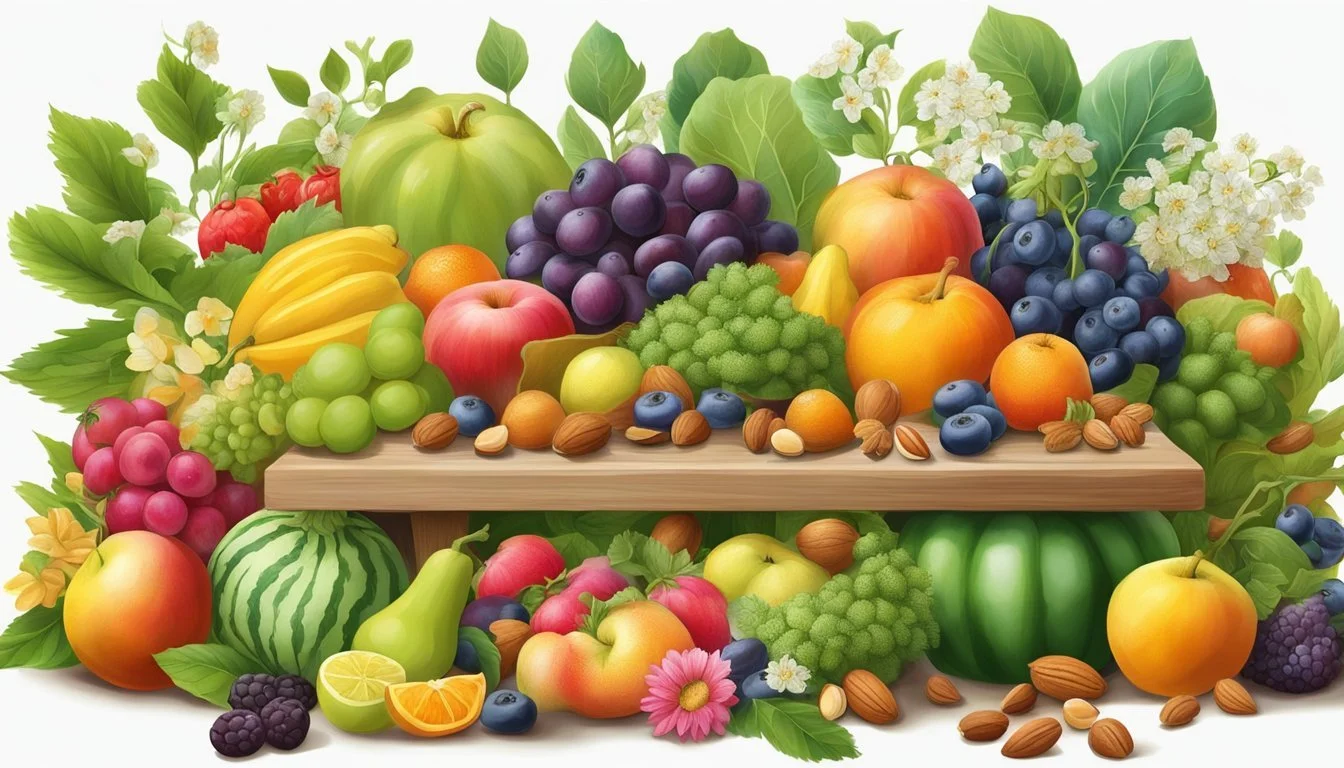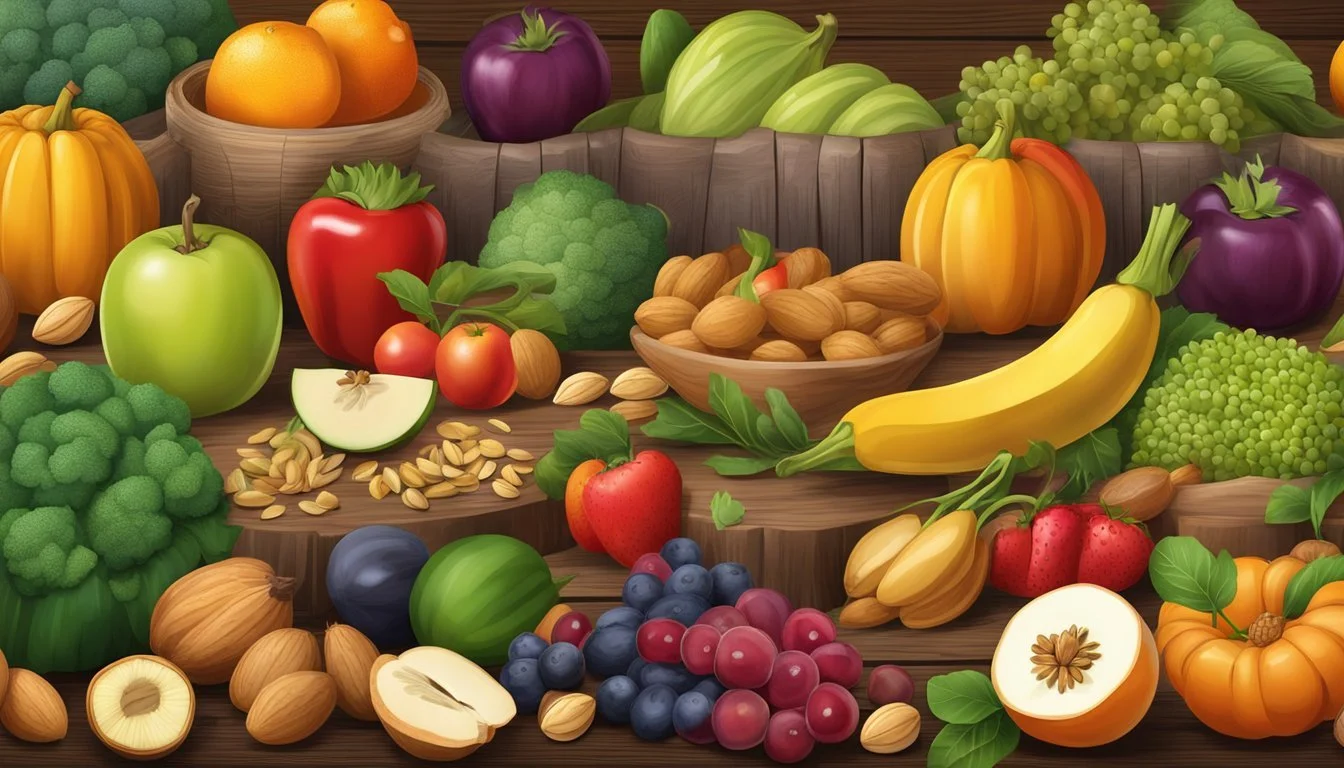Seasonal Grain-Free Recipes
Embrace Nature's Calendar with Healthy Eating Options
Embracing a grain-free diet doesn't mean having to sacrifice variety, especially with the abundance of seasonal produce available throughout the year. Eating with the seasons allows for a rotation of fresh produce that ensures meals are diverse, nutrient-dense, and aligned with natural growing cycles. The grain-free approach eliminates common grains like wheat, rice, and corn, relying instead on alternative sources of carbohydrates such as fruits, vegetables, and nuts to provide the body with essential energy and nutrients.
Seasonal eating not only supports local agriculture but also coincides with the body’s nutritional needs that vary throughout the year. In the spring, for example, lighter grain-free foods that incorporate ingredients like fresh peas, asparagus, and leafy greens, can be more appealing. They align with the body's inclination towards detoxification after a heavier winter diet. Moreover, seasonal recipes often require fewer artificial ingredients, as the natural flavors of ripe, in-season produce require less enhancement, leading to cleaner and healthy eating habits.
A grain-free, seasonal diet also emphasizes adaptability and creativity in the kitchen. It prompts an exploration of unfamiliar produce and innovative cooking techniques, which leads to a broadened culinary palette. Preparing meals with fresh, seasonal ingredients not only provides better taste and nutrition but also connects individuals to the natural world, promoting a harmonious rhythm with the changing environment.
Seasonal grain-free recipes offer a delightful opportunity to savor the vibrant flavors of each season while embracing a health-conscious approach to cooking. By incorporating innovative grain-free kitchen gadgets into your culinary endeavors, you can elevate your seasonal creations and infuse creativity into your cooking, making the experience both enjoyable and convenient. Embracing grain-free entertaining with seasonal dishes allows you to share the joy of nourishing and flavorful cuisine with friends and family, fostering a sense of connection and well-being.
Being mindful of your grain-free gut microbiota and making informed choices can contribute to supporting digestive health and overall vitality, while promoting grain-free heart health. Additionally, exploring the diverse offerings in the grain-free products market provides a wealth of options to enhance your seasonal recipes and dietary choices.
Following grain-free food bloggers can inspire new culinary adventures and provide valuable insights into creating delicious seasonal grain-free dishes. By embracing seasonal grain-free recipes, you can celebrate the bounties of each season while nurturing your well-being through wholesome and flavorful dining experiences.
Benefits of Seasonal Grain-Free Eating
Seasonal grain-free eating not only supports a person's overall well-being but also encourages a harmonious relationship with the environment. By focusing on foods that thrive in the current season, individuals may enhance their gut health and gain the nutritional advantages of peak-harvested produce.
Optimizing Gut Health
A grain-free diet, particularly for those following Whole30 or keto plans, can lead to improvements in gut health. Grains, especially when not properly prepared, can contain anti-nutrients like phytic acid that may disrupt gut flora. Removing grains might help reduce inflammation and enable the gut to repair and better absorb nutrients. However, it's essential to ensure that those on grain-free diets obtain adequate fiber from other sources to maintain healthy digestion. Plant-based options like leafy greens and seasonal vegetables are excellent for this purpose.
Aligning with Seasonal Produce
Seasonal grain-free eating emphasizes the consumption of produce that is freshly harvested and at its nutritional peak. The benefits of this practice include:
Higher Nutrient Density: Seasonal produce does not require long storage times, which means it can retain more vitamins and minerals.
Flavorful Options: When fruits and vegetables are picked and consumed within their natural growing season, they often have a superior flavor profile.
Environmental Sustainability: Choosing seasonal produce reduces the need for transportation over long distances, thereby lowering the carbon footprint associated with one's diet.
Adopting a grain-free, plant-based diet in sync with the seasons can provide variety throughout the year while ensuring that a person's nutritional needs are met. When properly planned, it allows for a diet rich in a diversity of foods, including plenty of vegetables, seeds, nuts, and legumes, tailored to the body's needs and the environment's offerings.
Breakfast Ideas
Crafting a satisfying grain-free breakfast can be a simple, nutritious way to start the day, especially when focusing on seasonal ingredients that cater to both sweet and savory preferences.
Grain-Free Granola and Yogurt
For those looking to blend crunch with creaminess, a bowl of grain-free granola paired with yogurt is a great choice. Granola can be homemade using a mix of seeds, such as pumpkin and sunflower, nuts like almonds and pecans, and binding agents such as almond flour. This combination provides a protein-packed start to the day. For a sweet touch, one can add diced seasonal fruits or a drizzle of honey. Vegans may opt for a dairy-free yogurt alternative, such as coconut or almond milk yogurt, to keep the meal plant-based.
Example recipe:
1 cup raw almonds (chopped)
1 cup pumpkin seeds
1/2 cup sunflower seeds
1/2 cup almond flour
2 tbsp coconut oil (melted)
Seasonal fruit (for topping)
Dairy-free yogurt (for serving)
Instructions:
Combine nuts, seeds, and almond flour with melted coconut oil.
Bake the mixture until golden brown.
Serve over dairy-free yogurt with seasonal fruit.
Savory Breakfast Bowls
Savory breakfast bowls can be the perfect vessel for a variety of grain-free ingredients. They can include a base of sautéed vegetables like spinach, mushrooms, and onions, or riced cauliflower (how long does cauliflower last?) for those seeking a lower-carb option. Toppings might include soft-boiled eggs or scrambled tofu for a boost of protein. One can further tailor these bowls with additions like avocado (how long does avocado last?), fresh herbs (how long do fresh herbs last?), or a sprinkle of nutritional yeast for a cheesy flavor without the dairy.
Example bowl components:
Riced cauliflower
Spinach
Mushrooms
Eggs or tofu
Avocado (sliced)
Nutritional yeast (optional)
Fresh herbs (chopped)
Creating these bowls offers an opportunity to incorporate a diversity of textures and flavors while keeping the meal aligned with the grain-free lifestyle.
Lunch Delights
When embracing a grain-free lifestyle, lunchtime offers a chance to relish in the diversity of flavors and nutrients from seasonal produce. With soups and salads that harness the freshness and vibrancy of veggies and citrus fruits, one can craft satisfying midday meals that are both nourishing and delicious.
Hearty Soups
Grain-free soups provide warmth and comfort, making use of an array of vegetables and proteins. A Chicken and Vegetable Broth brims with tender chicken pieces, a medley of seasonal vegetables like celery, and fresh herbs for a protein-packed dish. For a zestier option, Citrus-Infused Chicken Soup marries the tang of citrus fruits with succulent chicken, infused within a rich, aromatic broth. To prepare:
Sauté onions, garlic, and celery in olive oil.
Add chicken, broth, and a choice of citrus zest – such as lemon or orange.
Simmer until the chicken is cooked through and flavors meld.
Refreshing Salads
Salads offer a canvas to color with the myriad textures and flavors of seasonal greens and veggies. The Citrus Avocado Salad combines creamy avocado slices with a selection of citrus fruits like grapefruit and oranges, laid atop a bed of mixed greens, drizzled with a citrus vinaigrette. Alternatively, a Crunchy Veggie Bowl emphasizes the crispness of fresh produce such as beets and kale, complemented by a lemony dressing. Key components include:
A variety of greens: spinach, arugula, or kale.
Sliced or chopped vegetables: radishes, cucumbers, and beets.
A homemade dressing with olive oil, fresh lemon juice, and seasonings.
These grain-free recipes capture the essence of the season, incorporating fresh, local produce into satisfying dishes that energize and fulfill any lunchtime appetite.
Dinner Specials
When preparing grain-free dinner specials, a focus on fresh, seasonal produce can elevate a simple meal to a feast, perfect for family gatherings or quick weeknight dinners. The following sections will explore enticing entrees designed for these occasions.
Entrees for Family Gatherings
For family gatherings, grain-free entrees can be both luxurious and satisfying. One recommended dish is a Fesenjan-inspired stew, which is a Persian delight made with ground walnuts and pomegranate molasses, lending a rich, tangy depth to the sauce. A vegan twist might include roasted cauliflower or chicken for those not following a plant-based diet. Seasonal vegetables like sweet potatoes (What wine goes well with potatoes?) and carrots (how long do carrots last?) can complement the flavors while maintaining the grain-free virtue.
Seasonal Vegetable Fesenjan:
Base: Ground walnuts, pomegranate molasses
Protein: Roasted cauliflower or chicken
Vegetables: Seasonal, perhaps sweet potatoes in winter, zucchini in summer
This entree represents a heartwarming choice that effortlessly combines health and hedonism.
Quick and Easy Sheet Pan Meals
Quick and easy sheet pan meals are a godsend for busy weeknights, and there's no need to rely on grains to make them satisfying. Moroccan-spiced chicken and vegetables make for an exotic yet simple dinner option. Vegetables such as sweet potato, carrots, and cauliflower can roast alongside the protein, absorbing the warm spices of cumin, turmeric, and cinnamon. Garnishing with ingredients like dried cherries and pistachios adds texture and bursts of flavor, while a homemade feta yogurt sauce can offer a creamy balance to the spices.
Moroccan-Spiced Chicken Sheet Pan:
Protein: Chicken
Vegetables: Sweet potatoes, carrots, cauliflower
Spices: Cumin, turmeric, cinnamon
Garnish: Dried cherries, pistachios, homemade feta yogurt sauce
Such meals are a salute to efficiency and flavor, catering to grain-free and gluten-free diets without sacrificing taste or variety.
Satisfying Sides and Snacks
Navigating a grain-free lifestyle doesn't mean sacrificing the variety or flavor of your meals. This section focuses on providing delicious and nutritious vegetable sides as well as innovative grain-free snack options to complement any seasonal plate.
Grain-Free Vegetable Sides
A staple in the grain-free side dish arena is the use of hearty vegetables. One can't go wrong with Roasted Brussels Sprouts (how long do brussels sprouts last?)—a simple yet satisfying side that pairs perfectly with a myriad of seasonal dishes. They can be prepared by tossing in olive oil and baking in a preheated oven until crispy on the edges, and they offer an abundance of flavors when mixed with balsamic vinegar or sprinkled with smoked paprika.
Another popular choice is Mashed Sweet Potatoes, a naturally sweet and fibrous alternative to traditional mashed potatoes. They provide essential vitamins and can be seasoned with cinnamon or nutmeg to enhance their natural sweetness.
Grain-Free Vegetable Side Ideas:
Roasted Brussels Sprouts with Garlic and Olive Oil
Cinnamon Mashed Sweet Potatoes
Grilled Asparagus (What wine goes well with grilled asparagus?) with Lemon Zest
Stir-Fried Mixed Vegetables with Coconut Aminos
Innovative Snack Options
For those seeking a quick afternoon snack, Avocado slices sprinkled with lemon juice and chili flakes make a creamy and zesty choice. This fruit is rich in healthy fats and fiber, making it an ideal snack to keep energy levels stable throughout the day.
Healthy snacks can also be both satisfying and exciting. Opt for slices of crisp bell peppers, cucumber, or carrot sticks coupled with grain-free dips like guacamole or almond butter. These snacks provide the crunch many crave, without the grains.
Grain-Free Snack Ideas:
Avocado Halves with Lime and Sea Salt
Zucchini Chips Baked with Nutritional Yeast
Fresh Veggie Sticks with Guacamole Dip
Homemade Almond Flour Crackers with Olive Tapenade
Incorporating these grain-free side and snack options into one's diet ensures that meals remain diverse and flavorful, adhering to a health-conscious approach without compromising on taste or satisfaction.
Grain-Free Baking
Adopting grain-free baking allows one to enjoy seasonal ingredients through baked goods that cater to dietary preferences or needs. Ingredients like almond flour and coconut flour often replace traditional wheat flour, providing moisture and a tender texture. Seasonal produce such as sweet potatoes and carrots can add natural sweetness and unique flavors to these recipes.
Breads and Muffins
Sweet Potato Bread (What wine goes well with bread?): Utilizing sweet potatoes, a staple fall ingredient, one can create a moist and flavorful bread that is rich in nutrients. Sweet potatoes not only enhance the bread's flavor but also contribute to a soft texture.
Ingredients:
Mashed sweet potato
Almond flour
Eggs
Cinnamon
Carrot Muffins: With their natural sweetness, carrots are perfect for grain-free muffins. Carrots combined with cinnamon create a classic taste that encapsulates the essence of the season.
Preparation:
Combine grated carrots with almond flour and cinnamon.
Fold in wet ingredients until the batter is well mixed.
Bake until golden and a toothpick comes out clean.
Sweet Treats
Cauliflower Desserts: Cauliflower can be surprisingly versatile in grain-free baking. Its neutral taste and ability to absorb flavors make it suitable for various sweet recipes, from cakes to puddings.
Key Point: Cauliflower's moisture content helps keep desserts like chocolate cakes gluten-free and deliciously tender.
Cinnamon Cookies: Infused with cinnamon, these cookies are perfect for one's grain-free dessert repertoire. Cinnamon not only offers warmth and a rich aroma but also pairs beautifully with almond flour for a satisfying treat.
Recipe Tip: For a crunchy outside and chewy inside, one should carefully monitor the baking time and let the cookies cool on the baking sheet before transferring them.
Seasonal Recipe Collections
Seasonal eating involves selecting and preparing foods that are naturally available and at their peak of freshness during specific times of the year. Focusing on grain-free and potentially vegan or paleo options, these recipes not only maximize flavor but also align with health-conscious dietary preferences.
Winter Warmers
During the chill of winter, warmth can be found in hearty soups and stews. A grain-free vegan cabbage soup utilizes winter's crisp cruciferous vegetable, cabbage, complemented by the earthiness of beets and the anti-inflammatory powers of turmeric. For those on a paleo diet, a turmeric-spiced cauliflower rice can serve as a comforting, warm dish rich in flavor.
Spring Freshness
Spring brings a bounty of tender, new growth and rejuvenating flavors. Grain-free recipes in these months blossom with fresh herbs and lighter fare. A spiralized beet salad brightened with a generous mix of spring's fresh herbs cater to both vegan and paleo palates, employing the naturally sweet and earthy tones of beets.
Summer Flavor Burst
Summertime thrives with an abundance of colorful fruits and vegetables. Grain-free dishes that feature items such as strawberries can range from a simple strawberry avocado salsa to more intricate strawberry galettes with almond flour crust, providing a burst of summer flavor. These recipes are adaptable to vegan and paleo versions by substituting or omitting specific ingredients like sweeteners or dairy.
Autumn Harvest
As the air turns crisp, autumn's harvest offers a new assortment of produce. Vegan recipes can incorporate grain-free pumpkin breads, employing almond or coconut flours. Paleo enthusiasts might enjoy a roasted squash with a touch of cinnamon and nutmeg, showcasing autumn's robust flavors in a simple yet satisfying way.
Nutritional Insights
This section explores the nutritional content of grain-free recipes that align with seasonal eating. It offers a closer look at the essential macronutrients these recipes provide and the powerful health benefits of incorporating superfoods.
Understanding Macronutrients
Grain-free recipes often emphasize a balance of proteins, fats, and carbohydrates from non-grain sources. Proteins, especially from plant sources such as nuts and seeds, are protein-packed and vital for muscle repair and growth. They may tend towards paleo or keto principles, focusing on high-quality fats from avocados and coconut oil, while incorporating complex carbohydrates from vegetables like cauliflower and sweet potatoes, which promote gut health.
Proteins:
Nuts (Almonds, Walnuts)
Seeds (Chia, Pumpkin)
Fats:
Avocados
Coconut oil
Carbohydrates:
Cauliflower
Sweet Potatoes
The Role of Superfoods
Superfoods in seasonal grain-free recipes contribute not just to the taste but also to the overall health benefits. Turmeric and ginger, known for their anti-inflammatory properties, are commonly used spices that can enhance both the flavor and the nutritional profile of winter recipes. Fresh herbs, packed with antioxidants, are also a significant part of these recipes, often used to add depth of flavor without additional calories.
Turmeric: Anti-inflammatory, supports liver function.
Ginger: Aids digestion, combats nausea.
Fresh Herbs:
Parsley (Vitamin C, Iron)
Basil (Vitamin K, Antioxidants)
Grain-free recipes crafted with seasonal ingredients not only provide the body with essential nutrients needed during different times of the year but also support sustainable eating practices by utilizing locally available produce.
Adopting a Grain-Free Lifestyle
Adopting a grain-free lifestyle can offer various health benefits for those with gluten intolerance or for those looking to follow specific dietary plans like Whole30, keto, or a general gluten-free, dairy-free regimen. Making this transition involves learning new shopping habits, understanding how to navigate dining out, and integrating grain alternatives into daily meals.
Transition Tips
When beginning a grain-free diet, individuals should start by eliminating all grains from their pantry to avoid temptation. Substituting grains with alternatives like almond flour for baking or cauliflower for rice can keep meals interesting and satisfying. Gradual changes can help the body adjust—someone might begin with a strict 30-day program like Whole30 to reset their eating patterns, then continue with a less restrictive but still grain-free keto or paleo lifestyle.
Substitutes for Common Grains:
Rice: Replace with cauliflower rice, broccoli rice, or shirataki rice.
Wheat Flour: Use almond flour, coconut flour, or ground flaxseed.
Budget-Friendly Shopping
Grain-free ingredients can be more expensive, but shopping in bulk and focusing on in-season produce can control costs. Individuals should prioritize purchasing core items like fresh vegetables, high-quality proteins, and healthy fats.
Cost-Saving Tips:
Buy nuts and seeds in bulk and store properly.
Opt for less expensive cuts of meat and use slow cooking methods to make them tender.
Eating Out and Social Events
Navigating social situations while maintaining a grain-free diet can be challenging. Individuals should review menus ahead of time and not hesitate to ask for modifications to dishes to accommodate their dietary needs. For example, they may request a burger without the bun or a salad without croutons. When attending events, bringing a grain-free dish to share ensures that there will be something they can eat, and it introduces others to grain-free options.
Tips for Dining Out:
Look for dishes that are naturally grain-free like protein-based entrees and salads.
Communicate dietary restrictions clearly to the server and ask questions about menu items.








